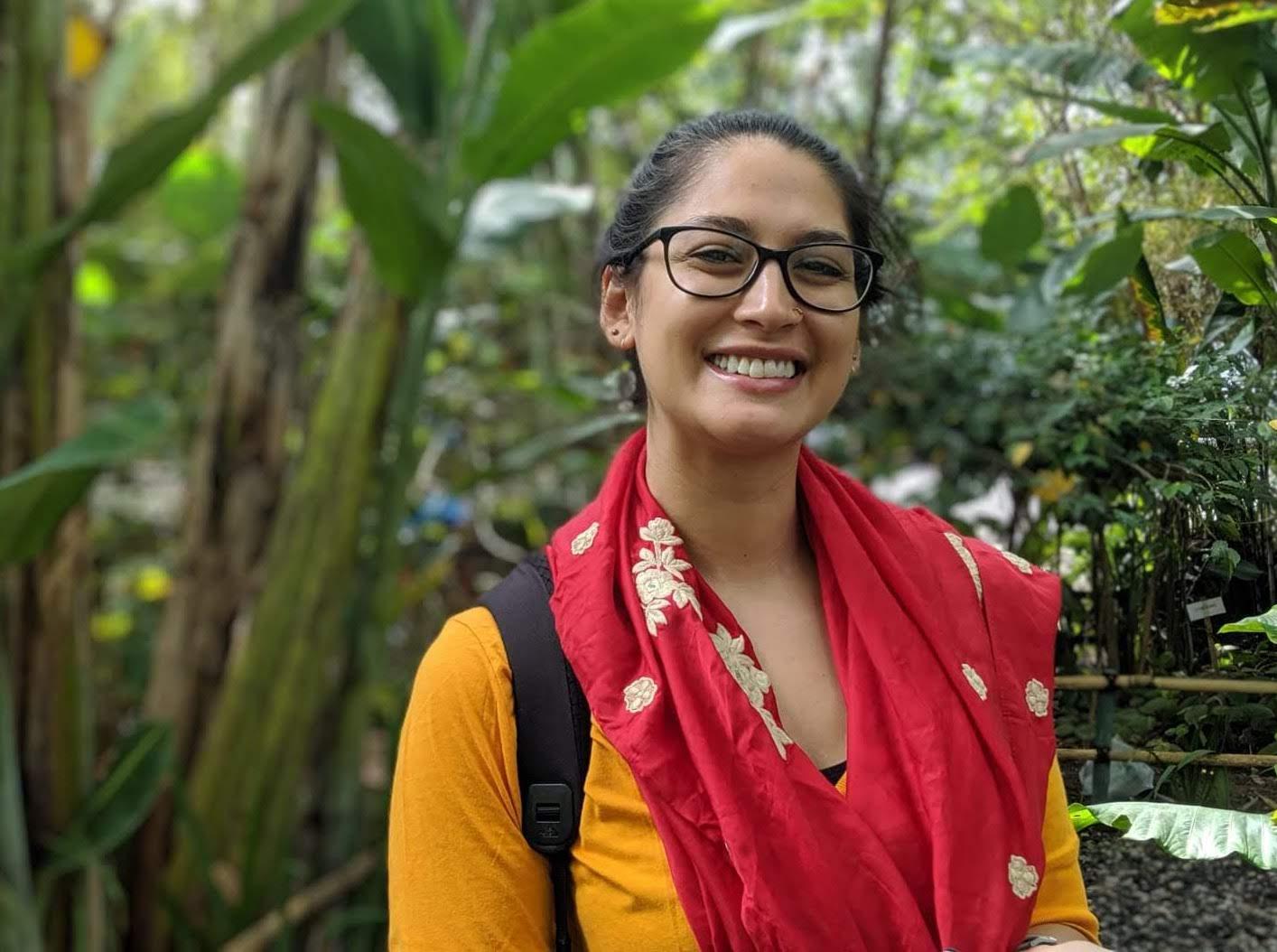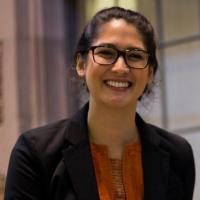
When collaborating with an instructor from another discipline, the assumptions we bring to the table, so often entrenched in disciplinary frameworks and jargon, must be vocalized and interrogated and reconciled, not just tacitly accepted.
A few years ago, dance scholar Dr. Ratna Roy (Ratna mashi, as I called her in dance practice) told me that she was co-teaching a class with a brain scientist at Evergreen College, and I swallowed my gulp of water a little too fast. Imagining a course in which students simultaneously learn the anatomy of the brain and classical Indian dance movement evoked an exciting picture in my mind of progressive pedagogy. At that time, I had recently joined the University of Washington’s graduate program in History with an expressed interest in interdisciplinary research, but my encounters with interdisciplinarity in the classroom were notably slim. I wanted to ask Ratna mashi more, but after several hours of dance practice, the tightening of my tired quadriceps and the ache in my rotator cuff were driving me down the steps of Velocity Studio on Broadway toward home—my curiosity stayed for the time being by the promise of a hot shower.
When I applied for the Mellon Fellowship for Reaching New Publics last year, it was the potential for new encounters with interdisciplinary teaching and learning that inspired me most. Since starting my fellowship last autumn, I have explored interdisciplinary approaches to teaching at the Seattle Colleges, especially through the Integrated Studies program. As an educational philosophy, integrated studies (sometimes called interdisciplinary or coordinated studies) encourages dynamic classroom learning in which students approach a specified theme from the perspective of different disciplines. This pedagogical model emerged as a K-12 curricular innovation around the turn of the century. Because society is not neatly divided into distinct subjects, connectivity across disciplines in the classroom was believed to better prepare students for the problems they would encounter in the future (replicating “authentic” real life scenarios).[i] A well-known 1997 report by Sandra Mathison and Melissa Freeman, “The Logic of Interdisciplinary Studies,” details the many “positive educational outcomes” for both students and teachers in K-12 integrated studies programs.[ii] Despite the significant research and the attention of K-12 educators, however, integrated studies has not become a leading model for most schools in the United States.
In higher education, on the other hand, integrated studies has gained significant traction as a pedagogical movement since the 1980s. At its core, integrated instruction is about cultivating connections across traditionally separated disciplines in order to work towards answering a question using a wide variety of tools. And it’s about learning how to learn, rather than achieving rote memorization. Students participate in a learning community, where the topics, skills, and assignments from two (or more) classes are woven together in a unified theme, cultivating camaraderie amongst classmates and mitigating the isolation that many undergraduate students face.[iii] Galvanizing this movement towards student-centered integrated studies was the Washington Center for the Improvement of Undergraduate Education at The Evergreen State College, founded in 1985. In a statement submitted to the Washington Center’s newsletter in 1987, then-governor Booth Gardner wrote about the importance of “working together to cross the traditional boundaries of educational politics,” and extolled the Washington Center as an invaluable resource for strengthening and transforming professional networks across institutions.[iv] Among the initial participating institutions were the Seattle Colleges: North, Central, and South campuses.
At North Seattle College, historian Jim Harnish was the driving force behind the emergence of integrated/coordinated studies on campus. At the 1987 annual meeting of the Association for General and Liberal Studies, Harnish presented alongside other faculty from Washington Center-affiliate institutions, discussing his use of primary texts as the organizing structure of his new Integrated Studies courses to facilitate meaningful and lasting student engagement with course themes and ideas.[v] This emphasis on text as means—of dialogue, of connectivity—remains a cornerstone of the Integrated Studies program at North.
Another noteworthy feature of all Integrated Studies courses is the format: the seminar. It is the seminar that often sets Integrated Studies courses apart from other lecture-based courses that are often taught within disciplines. In a seminar discussion, the instructor takes a step back and provides a space for students to dive deeply into a particular text. According to Harnish’s description of the integrated studies seminar, class time is “a time to ‘mine’ the text, to work it over as a group, to think aloud about it, and to test some ideas against the group.”[vi] The exchange of ideas during a seminar is made possible by the textual focus. The seminar is truly an exercise in textual scrutiny: the emphasis on textuality and the emphasis upon dialogue are integrally bound up with one another. Some instructors also expand student understandings of the text (and what constitutes a text) to include non-written sources, such as audio-visual materials.
Last quarter, I observed an Integrated Studies course at North entitled, “Defining America: Media History and Social Change,” led by Cristóbal Borges (History) and Jamie Wilson (English). The class session that day was dedicated to a fishbowl discussion, a seminar strategy that brings a handful of students into the center of the group (the “fish”) to discuss the prepared text. The “fish” take on different roles in the micro-discussion: keeping time, encouraging participation, locating quotes, redirecting the group back to the text as necessary, etc. Those who are not “fish” keep quiet and simply observe the small group discussion, but they can unpack what happened once the larger group is recombined (or if a new group of “fish” is assembled). The result: a deep engagement with the text at hand. I observed students generating new questions, making relevant connections, and raising new insights. More ground was covered than would have been likely (or possible) in a traditional lecture or instructor-led discussion. In a later conversation with me, Borges told me that he incorporates such strategies into all of his classes, including those designated as survey lectures, because of this generative potential.
Everyone I encountered in my inquiry into integrated studies shares the belief that this approach improves the teaching and learning experience. For students, classroom learning becomes more engaging and, in fact, more effective: the retention of material is greater due to its application beyond a single subject or discipline. Instructors as well as students report that integrated studies enhances their pedagogy. For many instructors, co-teaching in Integrated Studies programs means re-thinking the topics they teach and re-working how they teach them. When collaborating with an instructor from another discipline, the assumptions we bring to the table, so often entrenched in disciplinary frameworks and jargon, must be vocalized and interrogated and reconciled, not just tacitly accepted (How do we both understand and use the term ‘primary source’?). In the process, the instructors become more discerning educators (How do I teach, really?) who are accustomed to the continual process of learning.
My Mellon Fellowship at North Seattle College has shown that this kind of teaching and learning requires collaboration with others—across disciplines, and sometimes institutions. Integrated studies, as I understand it, renders interdisciplinarity, that which is notoriously difficult to put into practice, actually achievable. After learning more about integrated studies pedagogy, I am prompted to revisit my initial shock when Ratna mashi first told me about her co-teaching schedule. This kind of collaboration between experts, in this case, between a dancer and a brain scientist, who are traditionally cordoned off into separate academic units, is precisely what is needed to realize the possibilities of interdisciplinary knowledge production. And facilitating collaboration with others and across disciplines is what community colleges do often, and do best. For graduate students learning how to teach in interdisciplinary ways for the first time, community colleges are not only invaluable resources, but also potential sites of future interdisciplinary practice.
I am grateful to Dr. Cristóbal Borges for discussing the Integrated Studies Program at North Seattle College with me and for directing me to many of the resources mentioned here.
[i] Sandra Mathison and Melissa Freeman, “The Logic of Interdisciplinary Studies,” Report Series 2 (Albany, N.Y. : [Washington, DC]: National Research Center on English Learning & Achievement, University at Albany, State University of NY; US Department of Education, Office of Educational Research and Improvement, Washington, DC, 1998), 4.
[ii] For students, these outcomes include: “increased understanding, retention, and application of general concepts; better overall comprehension of global interdependencies, along with the development of multiple perspectives and points of view, as well as values; increased ability to make decisions, think critically and creatively, and synthesize knowledge beyond the disciplines; enhanced ability to identify, assess, and transfer significant information needed for solving novel problems; promotion of cooperative learning and a better attitude toward oneself as a learner and as a meaningful member of a community; increased motivation.” Mathison and Freeman, 17–18.
[iii] Lucy Dodge and Martha Kendall, “Learning Communities,” College Teaching 52, no. 4 (2004): 150–51.
[iv] Booth Gardner, “The Governor’s Letter: The Washington Center: A Key to Higher Education Progress,” Washington Center News 2, no. 1 (1987): 2.
[v] Barbara Leigh Smith, “Washington Center Panel at Annual AGLS Conference: Interinstitutional Pathways to Curricular Coherence,” Washington Center News 1, no. 2 (1986): 3.
[vi] Jim Harnish, “What’s in a Seminar” (North Seattle College, n.d.).
Katia Chaterji (she/her/hers)
Katia Chaterji was a 2020 Mellon Collaborative Fellow for Reaching New Publics with Jessica Bachman. Katia’s dissertation explores the relationship between Islam and the performing arts in the making of regional Islamic histories in maritime Southeast Asia.
